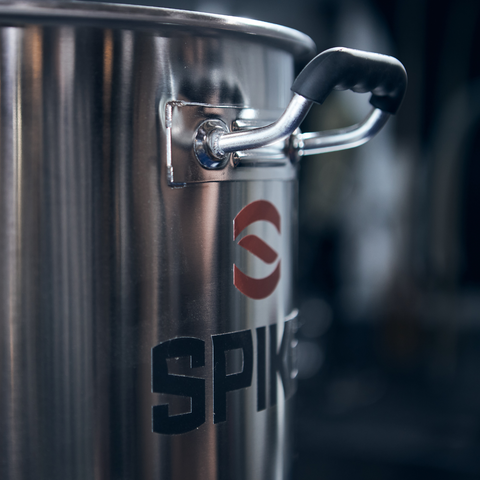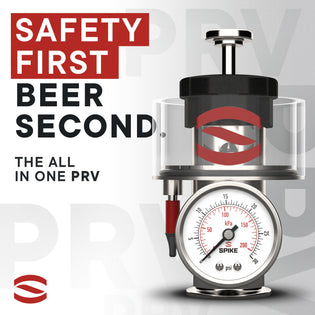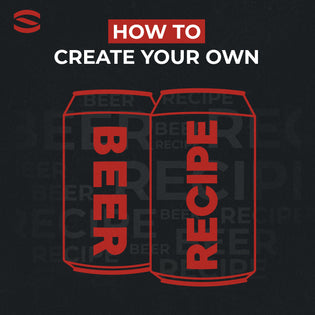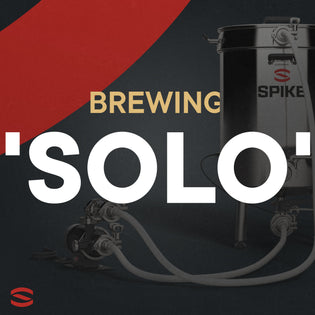A good brew kettle is like a good drinking buddy—reliable, sturdy, and always up for a good time. But with so many options out there, it's easy to get overwhelmed. Don't worry, we've got your back (and your beer).
Whether you’re a beginner or a seasoned home brewer, finding the right brew kettle for your needs is essential for creating delicious beer. In this guide, we’ll cover everything you need to know about choosing the right brew kettle, from the basics of what a brew kettle is to considerations when selecting one and our picks for the best brewing kettles. We’ll also answer some of the most frequently asked questions about brew kettles.
By the end of this guide, you’ll better understand what to look for in a brew kettle and be able to make an informed decision on the best one for your needs. So, let’s dive in because life's too short to drink bad beer or use a crappy kettle.
Click here to check out Spike and start brewing better beer.
What Is A Brew Kettle?
A brew kettle is an essential piece of equipment for any homebrewer. It is used to heat water and dissolve malt extract, hops, and other ingredients to create wort, which is the basis of all beer. Brew kettles come in various sizes, shapes, and materials and can be used for all-grain and extract brewing.
The most basic type of brew kettle is a simple pot with a lid and a single spigot. This type of kettle is often used for extract brewing and is great for beginners. It is usually made of stainless steel, aluminum, or copper and is relatively inexpensive.
More advanced types of brew kettles can include features such as internal thermometers, false bottoms, and valves. These features are more important for all-grain brewing as they allow for more precise control over the process.

Why Is Having A High-Grade Brew Kettle Important?
A high-grade brew kettle can mean the difference between a good beer and a great beer. It's not just about boiling the wort, it's about creating the perfect environment for the brewing process.
A high-grade brew kettle is important for several reasons. First, it’s made from a higher-quality material that is designed to withstand the intense heat of boiling wort. This ensures that the kettle will last longer and will not warp or corrode over time. It also helps to ensure that the flavor of the beer is not affected by any impurities in the kettle.
Second, a high-grade brew kettle is designed to provide the best results when boiling wort. It will have a larger surface area, which allows for more efficient heat transfer and faster boiling times.

Considerations When Selecting A Brew Kettle
With so many options out there, how do you choose the perfect one? Here are a few important considerations to keep in mind:
Size
The size of the kettle you need depends on the size of your brewing setup, the type of beer you plan to brew, and the amount of beer you plan to produce.
For most home brewers, a 10-gallon kettle is a good starting point. This size is large enough to brew 5-gallon batches of beer and can typically fit on most kitchen stoves. If you plan to brew large batches of beer, you may need a larger kettle. Kettles come in sizes ranging from 5 gallons to 50 gallons, so you can find one that will fit your needs.
Material
The material used to make the kettle will affect its durability, efficiency, and ease of cleaning. Stainless steel is the most popular material used for brewing kettles due to its durability and resistance to corrosion. It is also easy to clean and maintain and is considered to be one of the most sanitary options. Spike always uses 304 stainless steel on all pieces of equipment. It’s the Spike standard.
Aluminum is another popular material used for brewing kettles, as it is lightweight, durable, and relatively inexpensive. It is also a good conductor of heat, meaning it will heat the wort quickly and efficiently. The downside of aluminum is that it is prone to oxidation and is more difficult to clean than stainless steel.
Spigot
The spigot is the outlet used to transfer the liquid from the kettle to another vessel, such as a fermenter. The type of spigot you choose will depend on your needs and the size and shape of your brew kettle.
There are two main types of spigots:
- Welded
- Weldless
Welded spigots are welded to the kettle via a threaded fitting and require you to add a valve. Weldless spigots are attached to the kettle using a compression fitting. Both types of spigots are available in different sizes and styles, so you can choose the one that best suits your needs.
Welded spigots are generally more reliable than weldless spigots, as they will never leak. Weldless spigots are less expensive but more likely to leak and may require more frequent maintenance.
Handles
Handles are an important part of the brew kettle, as they provide stability and portability when transferring the kettle from one place to another. It is essential to select a brew kettle with handles that can support the weight of the kettle and any liquid inside it. It is also important to consider the type of handles available.
Some brew kettles come with plastic handles that are easy to clean and may be more comfortable to grip than metal handles.
However, plastic handles can also be more prone to breaking, so selecting a kettle with strong, durable handles is important. Metal handles are usually more durable but may be less comfortable to grip and harder to clean.
Spike Tank vs. OG
Choosing between the OG kettle (flat bottom) and the Spike Tank (bottom drain) is like taking your beer from "great" to "oh yeah."
The type of bottom you choose will depend on the kind of brewing process you’re using.
OG: The most common type of bottom is a flat bottom. This style of the bottom is ideal for direct-fire brewing. It distributes heat evenly and is great for boiling wort. This style of the bottom is also ideal for mashing because it allows for more precise temperature control over your mash.
Tank: New to the homebrewing scene, is the bottom drain brew kettle. Bottom drain kettles are a must for pro brewing, and now you can bring this pro level kettle to your home brewery! This robust kettle design was engineered to make post-Brew Day clean up a breeze! It’s called the Tank for a reason. It's as structurally sound as you'll ever find, features complete U.S. welded fittings, is bottom draining and has four sturdy splayed legs to keep it balanced and gives you room to work underneath. You simply won't find this kind of innovation with any other homebrewing product on the market.
Valve Type
The type of valve you choose is based on the fittings of your brew kettle (NPT or TC) and will affect the flow rate and pressure of your brew.
- NPT: Uses ball valves. Ball valves are opened and closed by turning a handle, which moves a ball inside the valve. This allows for precise control of the flow rate and pressure of the brew.
-
TC: Uses Butterfly Valves. They are opened and closed by turning a handle, which moves a butterfly-shaped disc inside the valve.
Lid
The lid should fit securely and tightly on the kettle.
Having a lid that can be easily removed is also important. This allows for easy access to the contents of the kettle, as well as for quick and easy cleaning. Depending on the type of lid, it may also provide some insulation, which can help maintain a consistent temperature inside the kettle. The lid should also be made of a durable material that can withstand high temperatures.
For a quicker clean up, switch out a standard lid with a CIP lid to completely clean your brew kettle from the inside out.

Ease To Clean
Cleaning and sanitizing your brew kettle is essential for producing quality beer and avoiding contamination. A brew kettle that is difficult to clean can lead to time-consuming and frustrating clean-up sessions.
A 304 stainless steel brew kettle is often the best option for cleaning. Stainless steel is non-porous, which means it won’t absorb bacteria or odors and is also highly resistant to corrosion. The fewer nooks and crannies on your brew kettle, the easier to clean.
Durability And Efficiency
A high-grade brew kettle should be able to withstand the rigors of brewing and last for years to come. Additionally, the kettle should be designed to maximize efficiency and make the most of your brewing ingredients.
When it comes to durability, stainless steel is the best material for a brew kettle. It’s strong, corrosion-resistant, and easy to clean. It also has excellent heat retention, allowing you to maintain consistent temperatures during the brewing process, or as we like to say, “Your Liver Will Fail Before Our Equipment Does.”

Our Picks For The Best Brewing Kettles
To help you find the best brew kettle for your needs, we’ve put together a list of our top picks for the best brewing kettles.
- For Those Just Starting Out, our Spike OG Kettle is an excellent choice. Everyone has to start somewhere, and the OG brew kettle is not only our tried and true product, but it’s the first piece of equipment we ever sold. The OG is made with the thickest material and U.S. welded fittings. It’s a solid piece of steel sold at a factory direct price. Whatever your use is, this kettle will hold up.
- For Those Looking to Elevate the Brew Day, our Spike Tank is a great option. We call it “The Tank” for a reason—it’s as structurally sound as you'll ever find, features complete U.S. welded fittings, is bottom draining and has four sturdy splayed legs to keep it balanced and gives you room to work underneath. It’s truly the last kettle you’ll ever need.
This stainless-steel monster features welded ports for the bottom drain, racking port, whirlpool, heating element, and temp probe.
- For Those Looking For Something Custom, we do our welding in house, which means we have the unique ability to build custom kettles to go with your dream brewery! We can add 1.5" or 2" tri-clamp ports, as well as full and half 1/2" NPT ports. Whether you want a heating element so you can convert your kettle to electric, a dedicated whirlpool port or a HERMS coil port, we’re ready and waiting to make your dream come true.
Having doubts or a hard time with how to go about it? Please, contact us now or email us at info@spikebrewing.com.
Choosing The Best Brew Kettle For Your Needs
Here are some steps to follow:
- Batch Size: The first step in choosing a brew kettle is to determine your batch size. How much beer do you want to brew at a time? This will help you choose the appropriate size of the brew kettle.
- Consider The Material: The most common materials for brew kettles are stainless steel, aluminum, and copper.
- Look At Thickness: The thickness of the kettle is important for heat distribution and retention. Thicker kettles will hold heat better and prevent scorching but will also take longer to heat up.
- Check For Features: Look for a kettle with features that will make your brewing process easier, such as a spigot for easy transfer of wort, a thermometer, and volume markings.
- Consider Your Budget: Brew kettles can range from around $50 to several hundred dollars. Determine your budget and choose a kettle that fits within it.
- Read Reviews: Before making a purchase, look for reviews that address the specific factors that are important to you.
Final Thoughts
When it comes to choosing the right brew kettle for your home brewery, there are many factors to consider. Selecting a kettle that meets your needs and budget is important. Ultimately, the best brew kettle for you is the one that allows you to make the best beer possible.
If you are just starting out, a smaller, more affordable kettle may be the best option. However, as you become more experienced and your brewing skills improve, investing in a high-quality kettle with more advanced features may be worthwhile.
Now that you have a better understanding of what to look for, go ahead and find the perfect kettle for your brewing needs! If you have any further questions or need additional guidance, don't hesitate to reach out to us.
Whether you're a new brewer just starting out or an experienced pro looking for advanced equipment, Spike has you covered. They offer products and packages for all levels of brewers, from new brewers to advanced brewers and even professional brewers.
To shop for the perfect equipment for your brewing needs, check out our New Brewer, Advanced Brewer, and Pro Brewer packages.
FAQs
Can you mash in a brew kettle?
Yes, you can mash in a brew kettle. This is a process where the grains are mixed with hot water, allowing the enzymes to break down the starches and convert them into fermentable sugars.
This is an important step in the beer brewing process, and a brew kettle is a perfect vessel for this.
Are electric kettles worth it?
Electric kettles are a great option for those who want to save time and energy. They are more efficient than traditional kettles, as they are able to heat the water faster. This means that you can get your beer brewing quicker, and with less effort.
They are also more convenient, as you can set the temperature and walk away, leaving the kettle to do all the work.
Can you ferment in a brew kettle?
Yes, technically you can.
However, It is not recommended to ferment in a brew kettle, as a brew kettle is primarily designed for boiling wort and not for fermenting beer. Normally you want a vessel that can fully seal, which a kettle does not, in order to prevent contamination. The high temperature during the boiling process can sanitize the kettle, but it can also damage the yeast cells and prevent them from fermenting properly.





